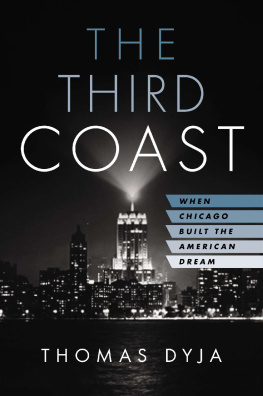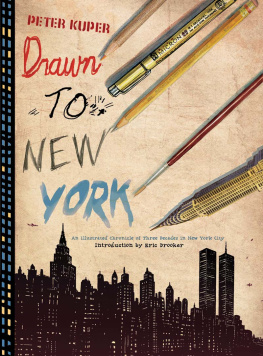Thomas Dyja - New York, New York, New York: Four Decades of Success, Excess, and Transformation
Here you can read online Thomas Dyja - New York, New York, New York: Four Decades of Success, Excess, and Transformation full text of the book (entire story) in english for free. Download pdf and epub, get meaning, cover and reviews about this ebook. year: 2021, publisher: Simon & Schuster, genre: Politics. Description of the work, (preface) as well as reviews are available. Best literature library LitArk.com created for fans of good reading and offers a wide selection of genres:
Romance novel
Science fiction
Adventure
Detective
Science
History
Home and family
Prose
Art
Politics
Computer
Non-fiction
Religion
Business
Children
Humor
Choose a favorite category and find really read worthwhile books. Enjoy immersion in the world of imagination, feel the emotions of the characters or learn something new for yourself, make an fascinating discovery.

- Book:New York, New York, New York: Four Decades of Success, Excess, and Transformation
- Author:
- Publisher:Simon & Schuster
- Genre:
- Year:2021
- Rating:4 / 5
- Favourites:Add to favourites
- Your mark:
- 80
- 1
- 2
- 3
- 4
- 5
New York, New York, New York: Four Decades of Success, Excess, and Transformation: summary, description and annotation
We offer to read an annotation, description, summary or preface (depends on what the author of the book "New York, New York, New York: Four Decades of Success, Excess, and Transformation" wrote himself). If you haven't found the necessary information about the book — write in the comments, we will try to find it.
Thomas Dyja: author's other books
Who wrote New York, New York, New York: Four Decades of Success, Excess, and Transformation? Find out the surname, the name of the author of the book and a list of all author's works by series.
New York, New York, New York: Four Decades of Success, Excess, and Transformation — read online for free the complete book (whole text) full work
Below is the text of the book, divided by pages. System saving the place of the last page read, allows you to conveniently read the book "New York, New York, New York: Four Decades of Success, Excess, and Transformation" online for free, without having to search again every time where you left off. Put a bookmark, and you can go to the page where you finished reading at any time.
Font size:
Interval:
Bookmark:


Also by Thomas Dyja
Nonfiction
The Third Coast: When Chicago Built the American Dream
Walter White: The Dilemma of Black Identity in America
Only Connect: The Way to Save Our Schools with Rudy Crew
Fiction
Play for a Kingdom
Meet John Trow
The Moon in Our Hands

Simon & Schuster
1230 Avenue of the Americas
New York, NY 10020
www.SimonandSchuster.com
Copyright 2021 by Kelmscott Ink, Inc.
All rights reserved, including the right to reproduce this book or portions thereof in any form whatsoever. For information, address Simon & Schuster Subsidiary Rights Department, 1230 Avenue of the Americas, New York, NY 10020.
First Simon & Schuster hardcover edition March 2021
SIMON & SCHUSTER and colophon are registered trademarks of Simon & Schuster, Inc.
For information about special discounts for bulk purchases, please contact Simon & Schuster Special Sales at 1-866-506-1949 or .
The Simon & Schuster Speakers Bureau can bring authors to your live event. For more information or to book an event, contact the Simon & Schuster Speakers Bureau at 1-866-248-3049 or visit our website at www.simonspeakers.com.
Interior design by Kyle Kabel
Jacket design by Rodrigo Corral
Jacket photograph by Orbon Alija/Getty Images
Library of Congress Cataloging-in-Publication Data
Names: Dyja, Tom, author.
Title: New York, New York, New York : four decades of success, excess, and transformation / by Thomas Dyja.
Description: First Simon & Schuster hardcover edition. |
New York : Simon & Schuster, 2021. | Includes index.
Identifiers: LCCN 2020032025 (print) | LCCN 2020032026 (ebook) |
ISBN 9781982149789 (hardcover) | ISBN 9781982149796 (paperback) |
ISBN 9781982149802 (ebook)
Subjects: LCSH: New York (N.Y.)History20th century. |
New York (N.Y.)Politics and government1951- | New York (N.Y.)Social conditions.
Classification: LCC F128.55 .D93 2021 (print) | LCC F128.55 (ebook) | DDC 974.7dc23
LC record available at https://lccn.loc.gov/2020032025
ISBN 978-1-9821-4978-9
ISBN 978-1-9821-4980-2 (ebook)
To Suzanne, Who Brought Me Back
When asked to name his three favorite American cities,
Holly Whyte said,
New York.
New York.
New York.
S now again this morningfour inches, said the AccuWeather Forecastafter a foot and half last week. Snow across the hundred acres of broken boards, mounds of brick, bent pipe, and garbage around Charlotte Street and Boston Road. Snow edged the sills of burnt-out apartment buildings, dusted shards of glass and mattresses left behind. Thered been some 63,000 fires in the South Bronx in the last two years; little point in plowing.
Today, Valentines Day 1978, was officially I Love New York Day.
Jimmy Carter had visited these desolate blocks last October, made thin promises as photographers focused on a landscape hopeless as the moon. Wed given up on the moon by then, along with just about everything else. Saigon had fallen; Nixon had resigned. Three decades of economic expansion had ended with a thud. Factories were closing. A dollar bought half of what it did ten years before; the speed limit, to save gas, was now a poky 55. So as Americas big, bright, exceptional promise of eternal growth blew apart, Carter had offered up Charlotte Street as a ruin so apparently complete that the rest of the failing nation could say that at least they werent there.
At Southern Boulevard, 18 feet in the air, the #5 train emerged from behind a hollowed building, bubbly orange, green, red, and blue wordsDaze, Blade, Futurapainted on its sides. Inside, it stunk of pot and piss; dense black scribbles over the windows and walls. Every stop along the way to Brooklyn, bundled riders winced at the graffiti, at the smell, at the parade of annoyance and threat that was daily life in New York circa 1978: track fires and dog shit, bad reception and cockroaches, that high-heeled lady upstairs with no rugs and the mugger around the next corner. Hello from the gutters of N.Y.C., wrote serial killer Son of Sam to the Post, which are filled with dog manure, vomit, stale wine, urine and blood. In their camel hair coats, Frye boots, and shiny Yankees jackets, New Yorkers stepped over and through it all this I Love New York Day, shoved past mounds of uncollected garbage bags. Some 6.8 million people lived in New York City in 1978, down a million from ten years before; middle-class Blacks and Puerto Ricans had joined the White flight. Pocked with cracks and empty corners, old New York was coming apart in chunks. A dump truck fell through the West Side Highway. Famed exorcist Malachi Martin knew for a fact that demons hunted lost souls on the benches of Bryant Park. Few New Yorkers bothered with self-control. People see it as bad, one young man told the Times, and they feel they cant do anything about it. So they do their little bit to make it worse. Public space was yours to use as you pleasedgo ahead and toss your hot dog wrapper on the sidewalk, piss between parked cars. Keepers at the Childrens Zoo had stood by watching as a man molested one of their geese.
Then the change began. Over the next thirty-five years, three different New Yorks evolved in lurches; three very similar cities with much of the same DNA, but each bigger, faster, and sleeker than the one before, each one more merciless and beautiful. The Koch era was the Renaissance; after brutal Retrenchment came dazzling, greedy years that spiraled back down amid crack, AIDS, and a social gout of too much too fast. The next four years of David Dinkins left the citys liberal traditions battered but laid the foundation for the safe streets and dotcom excess of Rudy Giulianis Reformation in the 90s. After the planes hit on 9/11 and a brief state of grace, the shaky city handed itself over to technocratic, philanthropic billionaire Michael Bloomberg who wove City Hall into his personal empire, reimagining New York to look very much like him: visionary and strategic, driven by data and good taste, rich beyond measure, and fatally detached from those it left behind.
By New Years Eve 2013, when Bloomberg delivered his good-bye atop a desk in City Hall, New York had experienced the most dramatic peacetime transformation of a city since Haussmann rebuilt Paris, greener and safer than it had ever been, from Bryant Parks lawn and the blocks of tidy homes across the South Bronx to the million-dollar brownstones in Bed-Stuy. Rumpelmayers and Billys Topless were gone, along with CBGB, subway graffiti, and that dog shit on the sidewalk. Good luck finding a place to smoke. The murder rate had dropped to a then all-time low of 333. Entire neighborhoods had been culturally, racially, economically, and physically remade; bedraggled Williamsburg was hip, Sunset Park burst with Fuzhou Chinese. Altogether some 3.6 million immigrants had come through since 1978, and 1.5 millionthe entire population of Philadelphiastayed. City Hall was solvent.
But the city of our memories, that thrilling cesspool where anything could happen, site of secret rituals officiated by Santera priests, home of dowagers on Beekman Place, refuge from everything straight and commonthat city seemed to have slipped under a sea of gold. The rich were no longer rich; they were imperial. Chain stores devoured mom and pops. Camp had been domesticated; rage, sex, and high art defanged, rents out of reach, the NYPD an army. Hip Hop was mainstream, but the Twin Towers were nowhere to be found. Depending on your mood, your age, your bank account, New York was now horrifying, or wonderful, and even that changed day-to-day, moment-to-moment.
Font size:
Interval:
Bookmark:
Similar books «New York, New York, New York: Four Decades of Success, Excess, and Transformation»
Look at similar books to New York, New York, New York: Four Decades of Success, Excess, and Transformation. We have selected literature similar in name and meaning in the hope of providing readers with more options to find new, interesting, not yet read works.
Discussion, reviews of the book New York, New York, New York: Four Decades of Success, Excess, and Transformation and just readers' own opinions. Leave your comments, write what you think about the work, its meaning or the main characters. Specify what exactly you liked and what you didn't like, and why you think so.





